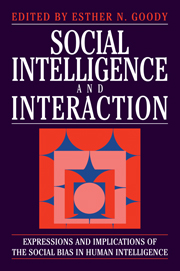 Social Intelligence and Interaction
Social Intelligence and Interaction Book contents
- Frontmatter
- Contents
- List of contributors
- Conventions used in transcripts
- Preface
- Introduction: some implications of a social origin of intelligence
- Part I Primary processes
- Part II The interactive negotiation of meaning in conversation
- Part III Genres as tools that shape interation
- Part IV Expressions of a social bias in intelligence
- 9 Divination as dialogue: negotiation of meaning with random responses
- 10 Social intelligence and prayer as dialogue
- 11 Interactional biases in human thinking
- 12 Stories in the social and mental life of people
- Consolidated bibliography
- Index
10 - Social intelligence and prayer as dialogue
Published online by Cambridge University Press: 09 January 2010
- Frontmatter
- Contents
- List of contributors
- Conventions used in transcripts
- Preface
- Introduction: some implications of a social origin of intelligence
- Part I Primary processes
- Part II The interactive negotiation of meaning in conversation
- Part III Genres as tools that shape interation
- Part IV Expressions of a social bias in intelligence
- 9 Divination as dialogue: negotiation of meaning with random responses
- 10 Social intelligence and prayer as dialogue
- 11 Interactional biases in human thinking
- 12 Stories in the social and mental life of people
- Consolidated bibliography
- Index
Summary
Homo sapiens is the clever hominid: primate social intelligence plus language
This chapter is part of a long-term project for the teasing out of implications of a social origin of human intelligence – for of course our species is distinguished as Homo sapiens sapiens – the intelligent hominid. Recent ethological research argues convincingly that primates are on many measures highly intelligent, and that this can best be explained as a product of social interdependence. Higher primate species appear to have a progressively greater capacity to cognitively model responses of others. For convenience this modelling of alternative contingent responses to others' actions can be termed anticipatory interactive planning (AIP). It is also argued in the Introduction that human intelligence was intimately linked to the emergence of language, which fundamentally changed the ways in which primates managed social interdependence.
Spoken language offers ways of influencing others' behaviour. It permits more elaborate negotiation of social interactions, the negotiation of joint AIP strategies. It becomes possible to seek cooperation with one's own goals through the exchange of information (‘there are more nuts over there under the big tree’); and to manipulate relationships themselves through asking, pleading, begging, pretending, threatening, insisting, promising. Spoken language became, as it continues to be, central to our human AIP modelling. As speech presumes an exchange of messages, this makes dialogue, literally ‘speaking alternately’, a fundamental form in hominid sociality. The importance of an exchange of messages for the emergence of a lexicon, i.e. shared meanings, is modelled by Hutchins and Hazlehurst in Chapter 2.
- Type
- Chapter
- Information
- Social Intelligence and InteractionExpressions and implications of the social bias in human intelligence, pp. 206 - 220Publisher: Cambridge University PressPrint publication year: 1995
- 5
- Cited by


